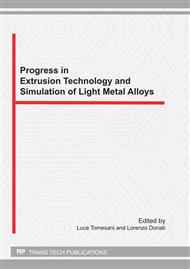p.197
p.205
p.215
p.223
p.233
p.241
p.249
p.257
p.265
Constitutive Laws for the Deformation Estimation of Extrusion Die in the Creep-Fatigue Regime
Abstract:
Tools are exposed to severe working conditions during the hot extrusion process. In particular, dies and mandrels can be subjected to an excessive amount of deformation as a result of the developed high cyclic loads and temperatures. In this scenario, a physical experiment reproducing the thermo-mechanical conditions of a mandrel in a porthole die was performed with the Gleeble machine on the AISI H11 tool steel with the aim to investigate the mechanisms that influence the die deformation. The design of experiment consisted of 4 levels of temperature, 3 levels of stress and 3 types of load, i.e. pure creep, pure fatigue and creep-fatigue. In all the testing conditions, a comparable pattern of the mandrel displacement-time curve was found reproducing the 3 stages of softening typical of the strain evolution in a standard creep test but with a marked primary phase. Thus, with the aim to identify an easy-applicable equation to estimate the die deformation, the time hardening creep law was chosen. Coefficients of the time-hardening law were optimized, for each testing condition, on the basis of experimental data starting from values for similar alloys taken from the literature. Results in terms of mandrel displacement were then compared to experimental data for the creep-fatigue condition at different stress and temperature levels. The values found were validated against additional experimental data performed with different specimen geometries. A good average agreement was found between experimental and numerical results. The developed procedure was then applied to an industrial die.
Info:
Periodical:
Pages:
233-240
Citation:
Online since:
September 2011
Authors:
Keywords:
Price:
Сopyright:
© 2012 Trans Tech Publications Ltd. All Rights Reserved
Share:
Citation:


